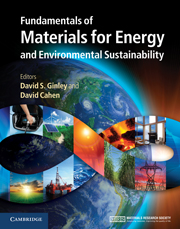Book contents
- Frontmatter
- Contents
- Contributors
- Preface
- Acknowledgments
- Part 1 Energy and the environment: the global landscape
- Part 2 Nonrenewable energy sources
- Part 3 Renewable energy sources
- 17 Solar energy overview
- 18 Direct solar energy conversion with photovoltaic devices
- 19 Future concepts for photovoltaic energy conversion
- 20 Concentrating and multijunction photovoltaics
- 21 Concentrating solar thermal power
- 22 Solar thermoelectrics: direct solar thermal energy conversion
- 23 Off-grid solar in the developing world
- 24 Principles of photosynthesis
- 25 Biofuels and biomaterials from microbes
- 26 Biofuels from cellulosic biomass via aqueous processing
- 27 Artificial photosynthesis for solar energy conversion
- 28 Engineering natural photosynthesis
- 29 Geothermal and ocean energy
- 30 Wind energy
- Part 4 Transportation
- Part 5 Energy efficiency
- Part 6 Energy storage, high-penetration renewables, and grid stabilization
- Summary
- Appendix A Thermodynamics
- Appendix B Electrochemistry
- Appendix C Units
- Index
- References
19 - Future concepts for photovoltaic energy conversion
from Part 3 - Renewable energy sources
Published online by Cambridge University Press: 05 June 2012
- Frontmatter
- Contents
- Contributors
- Preface
- Acknowledgments
- Part 1 Energy and the environment: the global landscape
- Part 2 Nonrenewable energy sources
- Part 3 Renewable energy sources
- 17 Solar energy overview
- 18 Direct solar energy conversion with photovoltaic devices
- 19 Future concepts for photovoltaic energy conversion
- 20 Concentrating and multijunction photovoltaics
- 21 Concentrating solar thermal power
- 22 Solar thermoelectrics: direct solar thermal energy conversion
- 23 Off-grid solar in the developing world
- 24 Principles of photosynthesis
- 25 Biofuels and biomaterials from microbes
- 26 Biofuels from cellulosic biomass via aqueous processing
- 27 Artificial photosynthesis for solar energy conversion
- 28 Engineering natural photosynthesis
- 29 Geothermal and ocean energy
- 30 Wind energy
- Part 4 Transportation
- Part 5 Energy efficiency
- Part 6 Energy storage, high-penetration renewables, and grid stabilization
- Summary
- Appendix A Thermodynamics
- Appendix B Electrochemistry
- Appendix C Units
- Index
- References
Summary
Focus
Photovoltaic (PV) conversion of solar energy could be much more effective than it is currently, using basic p–n junctions. The approaches required to reach theoretical conversion limits (~90%) are very challenging. Some have already been demonstrated, such as multijunction devices. Others, with considerable improvements in the description of excited states in condensed matter and in nanoscience, might be on the verge of a breakthrough. Given current knowledge about solar energy conversion and materials science, is it possible to achieve the ultimate solar cell?
Synopsis
Photovoltaic solar cells are now commonplace, and their development has taken advantage of the progress that has been made in electronics. Yet, they are still expensive and far from the performances that could, in principle, be achieved. This chapter first describes the limitations of PV devices as currently designed, before considering the various options being investigated to overcome these limitations. This description is put in perspective with achievable efficiencies according to thermodynamics. Then, we describe various options to experimentally approach the limits set on conversion efficiency of solar energy. While multijunctions are essentially presented in Chapter 20, here the emphasis is on other physical mechanisms than the ones currently operating in p–n diodes. These, first, include purely photonic conversion processes such as up and down conversion combined with a regular PV device, which provides additional power with relatively benign technology changes: an additional functional layer disconnected from the electrical circuit. The focus here is mainly on the optical properties of the additional materials. A second approach relies on the possibility of the absorber being able to harvest more energy from the solar spectrum than what semiconductors and molecules provide today: process of multi-generation of electron–hole pairs with a single photon or, conversely, processes by which several small-energy photons can contribute to the formation of an electron–hole pair. This not only requires new functional materials but also will change the device technology. Finally, we also look at approaches trying to tap into the heat produced upon absorption of photons to generate additional power. These devices are not isothermal, and, on top of optical and electronic properties, one needs to consider heat transfer between sub-parts of the system, and therefore take into consideration their thermal properties.
- Type
- Chapter
- Information
- Publisher: Cambridge University PressPrint publication year: 2011
References
- 3
- Cited by



